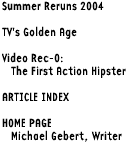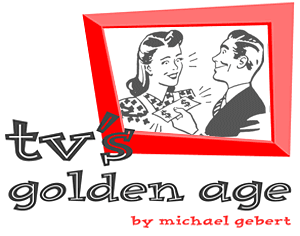


As some of you know (because I’ve hyped it so), I made a documentary about Chicago’s Maxwell Street market, following a bunch of serious food fanatics as they sampled the authentic and often exotic Mexican food there. (See here.) Shot it on my digital camcorder (with a friend on a second one), edited it on my Mac, total budget including goat eyeball tacos (no joke) about 50 bucks. It’s fun, if I do say so myself, because Maxwell Street is lively and my food fanatics are a pretty interesting bunch, most of them middle-aged and not too vain to be quirkily real characters on camera.
So one of the guys at our premiere party takes a DVD and passes it on to a Hollywood guy he knows. And the Hollywood guy shows it to his kid who thinks it’s funny in a dorky reality show kind of way (in Hollywood a 14-year-old’s opinion counts for more than his own judgement, of course). Before I know it, my purely-for-fun home movie is being watched at one of the largest, most powerful three-initialed talent agencies in the galaxy.
But don’t get too excited yet. Word comes back and—oh come on, you can guess. “They watched about five minutes of it,” I’m told. “The production values are kind of low.”
“Downright North Korean,” I say. “Tell me something I don’t know.”
“But they see how it could work if you had a younger, hipper cast and they were going around discovering the trendy places to eat and drink,” I’m told.
Oh! Of course! If we just took out the people whose realness make it interesting—my real food fanatics and the real immigrant vendors of Maxwell Street—and replaced them with the one thing that every other show on TV has, a cast full of vacuously perfect-looking twentysomethings, and sent them out to sip Cosmos at hot clubs with names like Torture and Ennui—if we just did that, then our concept would work! Young pretty people on TV! We never would have thought of that! No wonder you guys make the big bucks!
WELL, WHAT DID I EXPECT? YOUNG PEOPLE RULE TV. And why is that? Because that’s who we ad folks want most. And why is that? Because... hey, yeah, why is that?
The supreme desirability of the 18-to-34 demo is one of the few things everyone in advertising takes as being beyond dispute. In fact, this focus on people born in the 70s and 80s is one of the last unexamined holdovers of the 1950s still haunting our business.
It rests on two notions: First, that if you can win ‘em at 20, you’ll have ‘em for life. Yet try to think of brands you’ve been using since you were 20. Foods I once devoured have been banished in revulsion (Chicken in a Biskit?); a proud preference for Anchor Steam has long since given way to a constant quest for beer novelty; as for shampoos or detergents, I’m loyal to anybody on sale. Most tellingly, the brands that matter to me now often barely existed when I was 20—what’s a Starbucks, an IFC, a Nokia, a Trader Joe? If ad agencies spent big bucks to get me while I was still 18-to-34, they wasted it. Every American, at every age, is on that constant quest for novelty now; brand loyalty only lasts until the bottle is empty.
The second notion is that 18-to-34s are where the disposable income is. To which I can only say—been to Costco lately? Costco is built on the idea that its middle-aged customers have enough ready scratch to come in for paper towels and leave with a plasma TV, or at least a case of Maker’s Mark. This idea that we’re all flush at 24 but mortgaged and strapped at 36 is an absurdly dated relic of the pre-dual income, one-career-track-fits-all gray flannel suit era.
It would be deeply unhip, so it’ll never happen. But the first mega-agency to publicly launch a middle-aged advertising unit, and say they had big bucks to spend on media for that demo alone, would change the whole dynamics of our industry overnight—with themselves in the lead spot.
And when they do, hey, I have this idea for a TV show....